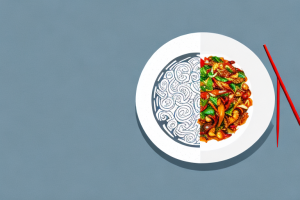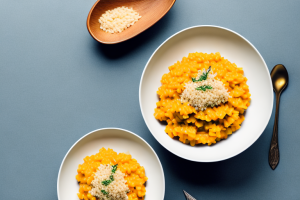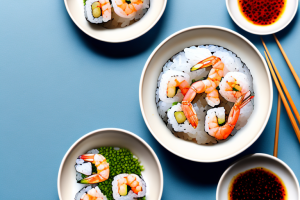How to make basmati rice with spiced lamb
9 min read
A pot of spiced lamb and basmati rice with aromatic herbs and spices
If you’re looking for a delicious and flavorful recipe that’s both easy to make and healthy, try making basmati rice with spiced lamb. Not only is this dish packed with nutrients and protein, but it’s also a flavorful and filling meal that can be enjoyed at any time of the day. Here’s a step-by-step guide on how to make this delectable dish, including the history, the different types of basmati rice, health benefits, essential ingredients, tips, tricks, and the frequently asked questions to help you create the perfect dish.
The history of basmati rice and how it became popular
Basmati rice is a long-grain rice that originated in the Indian subcontinent. The word “basmati” comes from the Hindi word “vasmati,” which means “fragrant.” It’s believed that the rice was first cultivated in the foothills of the Himalayas, and it was popular among the royal families of India and Pakistan.
Over time, the popularity of basmati rice spread to other countries, and it became a staple in many households. Today, basmati rice is not only popular in the East but also in the West, where it’s used in a variety of dishes, including biryanis, pilafs, and curries.
One of the reasons for the popularity of basmati rice is its unique aroma and flavor. The rice has a nutty and earthy taste, and it’s known for its delicate fragrance. This aroma is due to the presence of a chemical compound called 2-acetyl-1-pyrroline, which is found in high concentrations in basmati rice.
Another factor that contributed to the popularity of basmati rice is its nutritional value. Basmati rice is a good source of carbohydrates, protein, and fiber. It’s also low in fat and has a low glycemic index, which means it doesn’t cause a rapid spike in blood sugar levels. This makes it a healthy option for people with diabetes or those who are trying to manage their weight.
Different types of basmati rice and their unique flavors
There are many different types of basmati rice, each with their unique flavor and characteristics. Some popular varieties include:
- White Basmati Rice: This is the most commonly used type of basmati rice, with a delicate flavor and aroma. It has a slightly nutty taste and a light texture, making it perfect for a variety of dishes.
- Brown Basmati Rice: This is a healthier option as it contains more fiber and nutrients than white basmati rice. It has a nutty flavor and chewy texture, which make it perfect for salads and stews.
- Black Basmati Rice: This is a rare type of basmati rice with a rich, nutty flavor and a chewy texture. It’s higher in fiber and antioxidants than other types of basmati rice, making it a healthy choice.
- Red Basmati Rice: This is a whole-grain rice with a nutty flavor and chewy texture. It’s high in fiber and iron, making it a healthy option.
Aside from the popular varieties mentioned above, there are also other types of basmati rice that are worth trying. One of them is the Pusa Basmati Rice, which is known for its long grains and delicate flavor. Another type is the Tilda Basmati Rice, which is a premium quality rice that is aged for at least 12 months to enhance its flavor and aroma. Lastly, there’s the Basmati 370 Rice, which is a traditional variety that has been cultivated for centuries and has a unique flavor and aroma that is unmatched by other types of basmati rice.
The health benefits of basmati rice and spiced lamb
Basmati rice and spiced lamb are both packed with nutrients that are good for your health. Basmati rice is lower in calories than other types of rice and is a good source of carbohydrates, vitamins, and minerals. Lamb meat is a great source of protein and essential vitamins and minerals.
The spices used in the recipe, such as cumin, coriander, and turmeric, are also loaded with health benefits. They are anti-inflammatory, boost immunity, aid digestion, and improve heart health.
Additionally, basmati rice is a good source of fiber, which helps to regulate digestion and prevent constipation. It also has a low glycemic index, which means it can help regulate blood sugar levels and reduce the risk of diabetes.
Spiced lamb is also a good source of iron, which is important for the production of red blood cells and the prevention of anemia. It also contains zinc, which is essential for a healthy immune system and wound healing.
The essential ingredients required for making this dish
Here are the essential ingredients you’ll need to make basmati rice with spiced lamb:
- 1 cup basmati rice
- 2 cups water
- 1 pound lamb meat, cut into cubes
- 1 onion, chopped
- 4 cloves garlic, minced
- 1-inch piece ginger, minced
- 2 tomatoes, chopped
- 2 tablespoons oil
- 1 tablespoon cumin powder
- 1 tablespoon coriander powder
- 1 teaspoon turmeric
- Salt and black pepper to taste
Aside from the essential ingredients, you can also add some optional ingredients to enhance the flavor of the dish. You can add a pinch of saffron to the rice while cooking to give it a beautiful yellow color and a distinct aroma. You can also add some raisins and cashews to the rice to give it a sweet and nutty flavor.
For a healthier option, you can substitute the lamb meat with chicken or tofu. You can also add some vegetables like carrots, peas, and bell peppers to make it a more nutritious and colorful dish.
Tips for selecting the best quality lamb meat for this recipe
When selecting the lamb meat for this recipe, look for meat that’s pinkish-red with a marbled fat pattern. The fat should be creamy white, and the meat should be firm to the touch. Avoid meat that’s discolored or has a strong smell, as this could be a sign that it’s spoiled.
If you can, try using grass-fed or organic lamb meat, as it’s likely to be free from hormones and antibiotics.
Another factor to consider when selecting lamb meat for this recipe is the age of the animal. Generally, younger lamb meat is more tender and has a milder flavor, while older lamb meat has a stronger flavor and can be tougher. If you prefer a milder flavor, look for lamb meat that’s labeled as “spring lamb” or “baby lamb,” which is typically less than six months old. If you prefer a stronger flavor, look for lamb meat that’s labeled as “yearling” or “mutton,” which is typically over a year old.
Understanding the different spices used in the recipe and their benefits
The spices used in this recipe add a depth of flavor and have numerous health benefits.
- Cumin Powder: This spice is rich in antioxidants and has anti-inflammatory properties. It aids digestion, improves immunity, and promotes better sleep.
- Coriander Powder: This spice has a sweet, citrusy taste and is rich in vitamin C, K, and protein. It aids digestion, lowers cholesterol, and has antibacterial properties.
- Turmeric: Turmeric has powerful anti-inflammatory properties and is high in antioxidants. It’s been linked to lowering the risk of chronic diseases such as cancer, Alzheimer’s, and heart disease.
In addition to the spices mentioned above, there are other spices that can be used in this recipe to enhance its flavor and nutritional value. For example, ginger is a spice that has anti-inflammatory properties and can help with nausea and digestion. It also has a warm, spicy flavor that pairs well with the other spices in this recipe.
Another spice that can be added to this recipe is cinnamon. Cinnamon has been shown to help regulate blood sugar levels and has anti-inflammatory properties. It also has a sweet, warm flavor that can add depth to the dish.
Preparing the basmati rice perfectly for a fluffy texture
Preparing the basmati rice for this recipe is easy. Rinse the rice under cold water until the water runs clear. Let it soak in cold water for 30 minutes.
After the rice has soaked, drain the water and add the rice to a pot with 2 cups of water. Bring the rice to a boil, then reduce the heat to low and cover the pot with a tight lid. Cook the rice for 15-20 minutes until fully absorbed and fluffy.
Cooking the lamb to perfection: techniques and tricks
There are different methods to cook lamb meat, but the best way to cook it for this recipe is to sauté it in a pan.
- Preheat a large skillet over medium heat and add 2 tablespoons of oil.
- Add the chopped onions, minced garlic and ginger to the skillet and sauté for 2-3 minutes until softened and fragrant.
- Add the lamb meat to the skillet and sauté for 5-7 minutes until browned on all sides.
- Add the chopped tomatoes and the spices (cumin, coriander, turmeric, salt, and black pepper) to the skillet and stir well.
- Cover the skillet with a lid and let the lamb cook for an additional 10-15 minutes until it’s fully cooked through.
Combining the spices with the lamb: creating a flavorful marinade
The key to making spiced lamb is to create a flavorful marinade that’s packed with aromatic spices. Here’s how:
- Mix the spices (cumin, coriander, turmeric, salt, and black pepper) in a bowl to create a spice blend.
- Add the cubed lamb meat to the bowl and stir well to coat the lamb with the spice blend.
- Cover the bowl with cling film and let the lamb marinate in the fridge for at least 30 minutes or up to 2 hours to allow the spices to penetrate the meat.
How to cook the spiced lamb
After you’ve marinated the lamb, you can cook it using the method described in the previous section: sautéing it in a skillet with onions, garlic, and ginger, and adding chopped tomatoes and the spice blend.
Serving suggestions: accompaniments that complement this dish
This dish is best served hot and with some complementary side dishes. Here are some suggestions:
- Yogurt-based sauces, such as tzatziki or raita.
- Roasted vegetables, such as carrots or broccoli.
- Naan bread or pita bread.
- A fresh salad with cucumbers, tomatoes, and onions.
Tips for storing leftovers without compromising taste and texture
If you have leftovers, store them in an airtight container in the fridge for up to three days. To reheat, add a tablespoon of water to the container and microwave on high for 1-2 minutes until heated through.
Variations on this recipe: adding vegetables or other proteins to make it vegetarian or non-vegetarian friendly
If you want to make this dish vegetarian, you can substitute the lamb meat with vegetables such as cauliflower, sweet potatoes, or chickpeas. You can also add more vegetables to the recipe, such as green beans or bell peppers.
If you prefer a non-vegetarian version, you can substitute the lamb with beef or chicken.
Frequently asked questions about cooking with basmati rice and lamb
- Can you cook basmati rice in a rice cooker? Yes, you can cook basmati rice in a rice cooker. Simply rinse the rice and add it to the rice cooker with the required amount of water, as per the rice cooker’s instructions.
- How long does basmati rice take to cook? Basmati rice usually takes around 15-20 minutes to cook on low heat.
- How do you know when lamb is fully cooked? The best way to check if lamb is fully cooked is to insert an instant-read thermometer into the thickest part of the meat. It should read 145°F (63°C) for medium-rare, 160°F (71°C) for medium, and 170°F (77°C) for well-done.
- Can you freeze spiced lamb? Yes, you can freeze spiced lamb for up to three months in an airtight container or freezer bag.
With these tips and tricks, you’re now ready to make a flavorful and healthy basmati rice with spiced lamb. Enjoy!


